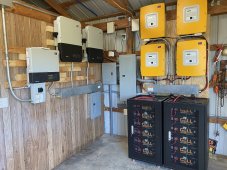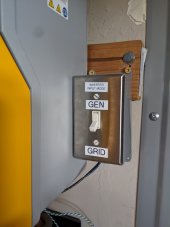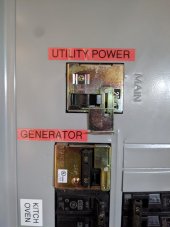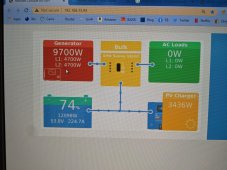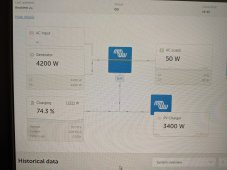I have two Envoys, one for the older system still just grid tied, and one for the other crazy off-grid behind the SIs. The Envoy can be used to change the parameters somewhat, it's supposed to set all micros on a system the same. Some of the grid profiles have some editable parameters. I tried setting some micros to trip off sooner and later, but I have decided to put all just at 60.5. Some I was able to set so they don't wait 5 minutes to power back on after tripping. The oldest m190/m210 and newer warranty replacements are 'IG' and 'IQ7' hardware, so not all grid profiles will take, so the older ones can be set differently than the new ones. You might be able to set them and then remove them from seeing the Envoy, but then can't monitor them. Monitoring them at night when powered from battery seems to not work; I think the Envoy or the micros assume there's no sun at night and don't log production.

I have tried multiple m190/m210 on a 400w panel, combos of 2 or 3 never seemed to make more power than just a single good micro. It looked like one would make near full power and the others would make low or no power, then they might alternate. As a side hobby, I sort through piles of older enphase micros removed from upgraded systems. Some are fine, some still work but intermittently put out less than full power. The ones I'm playing with batteries are not really good enough to put on a panel anymore, and they're $0/watt except for my time.
On the tractor Leaf module battery front & rear paralleled packs, there are JBD bms's that cut off at 3.63 bottom and 4.13 top. When the pack bms cuts off, it disconnects the DC side of charger, and disables the controls of the tractor. The charger AC input is controlled by a smartplug from the rpi controls, but doesn't know the battery pack SOC. In future I'll communicate with each BMS and turn off the charger or micro inside of the limits that are set in the BMS.
On a battery, yes should precharge the DC when connecting. I have a pushmower rebuilt 18650 pack w/ hoverboard bms, that I discharge with a single microinverter sometimes good for an hour or two. I manually precharge before plugging in anderson connector, otherwise it arcs. On the tractor batteries, I discharge it through the huge mower deck PTO contactor; I wouldn't notice the arc but I'm sure it's there, not good for the micro caps. On my long list is to make a smaller accy contactor circuit so the coil doesn't use so much power, and it should precharge before closing.
On my near term list is a controllable contactor transfer switch, to move my grid tied array from grid to the house off-grid system behind SIs. I'm losing net metering in a couple weeks, so I should avoid outflow generally. Off-peak outflow is worth very little so I should definitely use it where possible, and on-peak I would still send it out if everything in house is full and can't use it. Or leave the GT PV system on the grid and use something to pull of just the right amount: a charger like you mention or other variable loads like triac controlled water heater elements, a controllable EV charger, heatpump, AC. Then I'd be trying to juggle two independent system loads, grid and off-grid.
Newer micros or string inverters with freq/watts would work more cleanly. Although it's a little hacky and complicated, it works ok, it's entertaining and using items already onhand (DC solar trailer parts, old enphase micros) is so cheap. A single large lithium bank would be nice really and simple, maybe one day when the forklift batteries die?...
Sorry this went off the SI inverter topic so much. Here's
more about my system if there's interest.



